I just mixed two beaten eggs with dashi broth (2 tbs) and added sugar (2 tsp) and salt (a pinch). On medium heat, I put a small amount of vegetable oil (1 tsp) and poured in 1/4 of the egg mixture. When the bottom is set, I placed the cod roe/nori roll on the far side of the pan and started rolling using a spatula, Japanese cooking chop sticks and by tilting the pan to help with the rolling. I poured another 1/4 of the egg mixture into the open area of the pan, lifting the existing omelet so that the egg mixture flows under it. I rolled again and repeated the process until all the egg mixture was used resulting in a rectangular omelet (image below right).
Tuesday, November 29, 2011
Japanese omelet with Cod roe wrapped in nori 鱈子と海苔いりだし巻き
This is a dish I made from the cod roe left over after I made nagaimo dressed with cod roe. I posted a similar dish before but this time I wrapped the cod roe with a nori sheet before making it to a Japanese style rolled omelet. Again, I could have done a better job of centering the nori/cod roe.
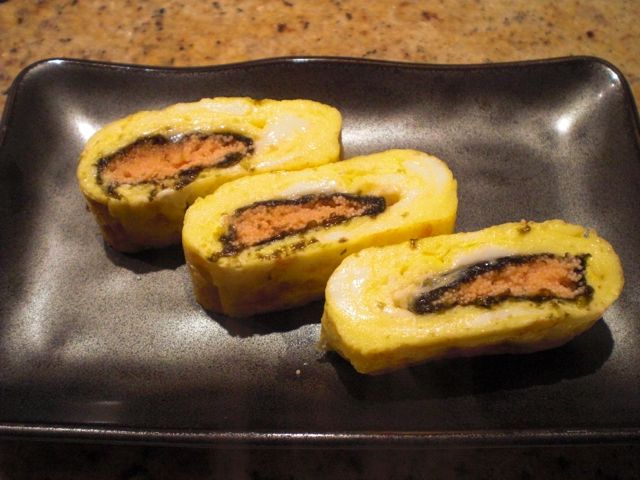
The cod roe is about a half a sack mixed with sake and Tabasco. I just cut the nori sheet to the width of the square frying pan I used to make the Japanese omelet. I put the cod roe in the center of the nori sheet and rolled it to make a rather flat roll (image below left).
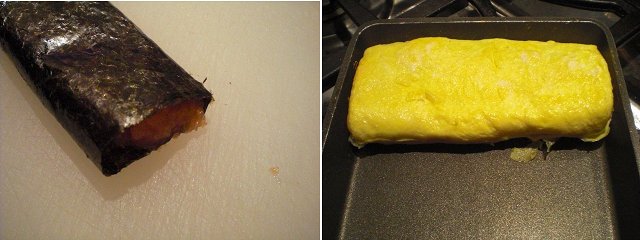
I cut it into 6 pieces (3 for one serving). The cod roe was just barely cooked and was lovely and moist. The addition of nori makes the rolling easier as well as adding a nice oceanic flavor to this dish. The tabasco gave it a slight zing. Of course, the egg part is slightly sweet and dashi adds nice soft texture and delicate flavor. There is no need for soy sauce since cod roe gives enough saltiness. The winning combination! We, of course, had cold sake with this.
Sunday, November 27, 2011
Nagaimo dressed in cod roe 長芋の鱈子和え
This is a small dish which goes perfectly with sake. This was again made from odd bits and pieces of left overs in the refrigerator which I try to use before they go bad. In particular I was concerned about one sack of cod roe or "tarako" 鱈子 which I bought the previous weekend and had been sitting forlornly in the refrigerator ever since. I posted few dishes using cod roe. I also found half a nagaimo 長芋 also left in the fridge and this is a quick dish I came up with. This is a sort of variation of this dish.
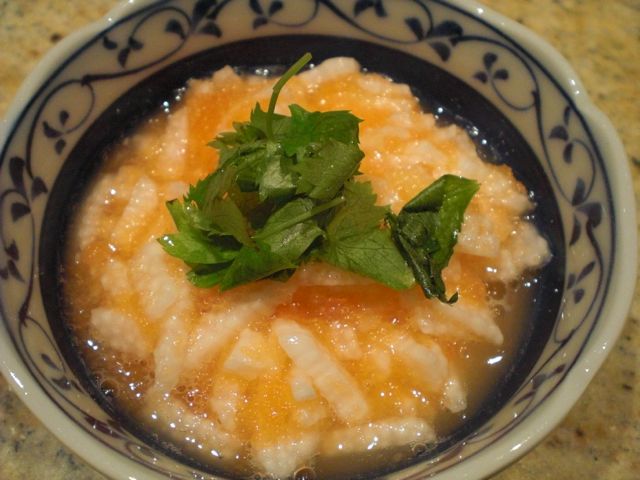
I first removed the roe from the sac by cutting a slit in the membrane and using the back of he knife, scraping off the roe. I added sake and Tabasco to make it a softer but not a too slushy consistency.
I also happened to have "mitsuba" 三つ葉, a Japanese green with a distinct favor. I removed the leaves from the stem and used it as a garnish. Unfortunately, this one did not have much flavor.
I peeled and sliced the nagaimo into thin disks (1/4 inch), halved, then, and cut into short match sticks. I dressed them with sushi vinegar. I drained the excess sushi vinegar from the nagaimo by lifting the nagaimo into another container. I added enough cod roe to make a nice mixture and mixed it into the magaimo (The remaining code roe was used for other dish).
I also happened to have "mitsuba" 三つ葉, a Japanese green with a distinct favor. I removed the leaves from the stem and used it as a garnish. Unfortunately, this one did not have much flavor.
This dish is a perfect small dish to start off the evening with cold sake. Tabasco added nice heat but was not too hot. The dish had an interesting texture and nice saltiness. This one has to be eaten with a spoon even if you are chopsticks jedi.
Friday, November 25, 2011
Sautéed octopus, mixed mushroom in sherry sauce 蛸ときのこのシェリー酒ソース
This is another octopus dish which could be served at an Izakaya. Since I used Fino sherry this could be considered in the Spanish style. Again, this was made totally on a whim in the moment and there is no recipe on which this is based. Since I had leftover mixed mushroom (white and brown clam shell and Royal trumpet mushrooms), which I bought a few days ago, and green asparagus, this is the dish I came up with as a starter.
 The octopus was slightly chewy but had a nice texture. Reduced sherry added a good nutty flavor, although this sherry is extremely dry you could also taste a very slight sweetness. The freshly ground black pepper gave a nice contrast. This dish will go with any drink but we had this with another classic Napa cab, Rudd "Crossroad" 2006 (75% cabernet sauvignon, 14% cabernet franc, 7% merlot, and 2% each petit verdot and malbec). This is the second label of Rudd estate. It is highly extracted with lots of upfront back fruit (black cherry, blueberry etc.) and nice vanilla and dark chocolate notes ending in firm tannin with a long finish. This dish went well with this wine.
The octopus was slightly chewy but had a nice texture. Reduced sherry added a good nutty flavor, although this sherry is extremely dry you could also taste a very slight sweetness. The freshly ground black pepper gave a nice contrast. This dish will go with any drink but we had this with another classic Napa cab, Rudd "Crossroad" 2006 (75% cabernet sauvignon, 14% cabernet franc, 7% merlot, and 2% each petit verdot and malbec). This is the second label of Rudd estate. It is highly extracted with lots of upfront back fruit (black cherry, blueberry etc.) and nice vanilla and dark chocolate notes ending in firm tannin with a long finish. This dish went well with this wine.
The amounts of these ingredients are all arbitrary. I had a leftover boiled octopus leg which I cut into about 12 thin slices (for two small servings). I also used green asparagus (4, After I removed and discarded the bottom parts, I cut the bottom half into thin slices on a slant and left the tips intact), garlic (two fat cloves finely minced). I removed the root ends of the clam shell mushrooms (not much whatever amount I had) and tore the royal trumpets along the length of the mushrooms in 4-5 pieces (one large)
I first sauteed the garlic and asparagus in a frying pan on medum flame with olive oil (1 tbs) for several minutes and added mushrooms. After the mushrooms were mostly cooked and soft, I added the octopus slices and sauteed for 30 seconds. I seasoned it with salt and cracked black pepper and added Fino sherry (3 tbs, or any dry sherry). I turned up the flame and quickly reduce the liquid. I added more freshly ground black pepper after I plated the dish for good measure.
I may have been a bit too heavy on the black pepper since my wife somehow inhaled it (this was meant to be tasted and eaten not inhaled) but nice black pepper taste was needed in this dish.
Wednesday, November 23, 2011
Octopus with tomato and olive イタリア風 たこ、トマト、黒オリーブ煮
I bought a boiled octopus leg at the Japanese grocery store on the weekend but I did not use it. I thought I should use it for something before it goes bad. I usually make Japanese dishes from octopus but this evening, we had already opened a bottle of "Bennett family Cabernet Sauvignon 2006". This wine will not go well with "sumiso-ae" 酢みそ和え. So, I concocted this dish; sort of Italian in style but I did not follow any recipe or I did not have any dish in mind to base this one on.

Octopus: The tentacle was medium in size, just boiled but not previously vinegared. I just sliced it rather thinly. To prevent it from getting too tough during cooking, I made shallow scores on one side.
 In a small skillet, I added olive oil (3 tbs) on low flame and added the garlic, red pepper flakes and slowly cooked it until the garlic became fragrant and very slightly brown. I added the tomatoes, chopped black olive, salt, and pepper. I turned up the heat to medium and cooked for 2-3 minutes (This is not really a tomato sauce). I then added slices of octopus and cooked for 30 more seconds or just until warm--not really cooking it further. I cut the heat and tasted it. I adjusted the seasoning by adding salt and a pinch of sugar since I thought it was a bit on the acidic side. I was thinking of adding lemon juice but changed my mind and only added grated lemon zest (using a micrograter) to give it a lemony flavor. I garnished with chopped parsley (If I had fresh thyme, I may have used thyme). My wife quickly toasted some bread (store bought semolina bread) for mopping up the juice.
In a small skillet, I added olive oil (3 tbs) on low flame and added the garlic, red pepper flakes and slowly cooked it until the garlic became fragrant and very slightly brown. I added the tomatoes, chopped black olive, salt, and pepper. I turned up the heat to medium and cooked for 2-3 minutes (This is not really a tomato sauce). I then added slices of octopus and cooked for 30 more seconds or just until warm--not really cooking it further. I cut the heat and tasted it. I adjusted the seasoning by adding salt and a pinch of sugar since I thought it was a bit on the acidic side. I was thinking of adding lemon juice but changed my mind and only added grated lemon zest (using a micrograter) to give it a lemony flavor. I garnished with chopped parsley (If I had fresh thyme, I may have used thyme). My wife quickly toasted some bread (store bought semolina bread) for mopping up the juice.
I decided on making a quick tomato sauce "on the fly". So I skinned Campari tomatoes (4) and cut them into large chunks. I crushed and minced garlic (2 fat cloves). I removed the stone from black olives (6 or so, I am not sure what kind).
 In a small skillet, I added olive oil (3 tbs) on low flame and added the garlic, red pepper flakes and slowly cooked it until the garlic became fragrant and very slightly brown. I added the tomatoes, chopped black olive, salt, and pepper. I turned up the heat to medium and cooked for 2-3 minutes (This is not really a tomato sauce). I then added slices of octopus and cooked for 30 more seconds or just until warm--not really cooking it further. I cut the heat and tasted it. I adjusted the seasoning by adding salt and a pinch of sugar since I thought it was a bit on the acidic side. I was thinking of adding lemon juice but changed my mind and only added grated lemon zest (using a micrograter) to give it a lemony flavor. I garnished with chopped parsley (If I had fresh thyme, I may have used thyme). My wife quickly toasted some bread (store bought semolina bread) for mopping up the juice.
In a small skillet, I added olive oil (3 tbs) on low flame and added the garlic, red pepper flakes and slowly cooked it until the garlic became fragrant and very slightly brown. I added the tomatoes, chopped black olive, salt, and pepper. I turned up the heat to medium and cooked for 2-3 minutes (This is not really a tomato sauce). I then added slices of octopus and cooked for 30 more seconds or just until warm--not really cooking it further. I cut the heat and tasted it. I adjusted the seasoning by adding salt and a pinch of sugar since I thought it was a bit on the acidic side. I was thinking of adding lemon juice but changed my mind and only added grated lemon zest (using a micrograter) to give it a lemony flavor. I garnished with chopped parsley (If I had fresh thyme, I may have used thyme). My wife quickly toasted some bread (store bought semolina bread) for mopping up the juice.
For an instant improvised dish, this was not bad at all. The octopus slices were tender and not chewy. The red pepper flakes gave a pleasant buzz in your mouth. Even some acidity did not complete with the red wine we were having. This cab from the Bennett family winery is a middle of the road Napa cab, not over-the-top and not too austere.
Monday, November 21, 2011
Green beans with black sesame sauce インゲンのねり黒ごま和え
This is another small dish I made one evening as a drinking snack. I usually use white sesame paste or "shiro-nerigoma" 白練り胡麻 to make sauce for green beans but I found that I was out of white sesame paste (it can be bought in a Japanese grocery sore and comes in a small can, glass jar, or plastic pouch) but I had black sesame paste "Kuro-nerigoma" 黒練り胡麻.
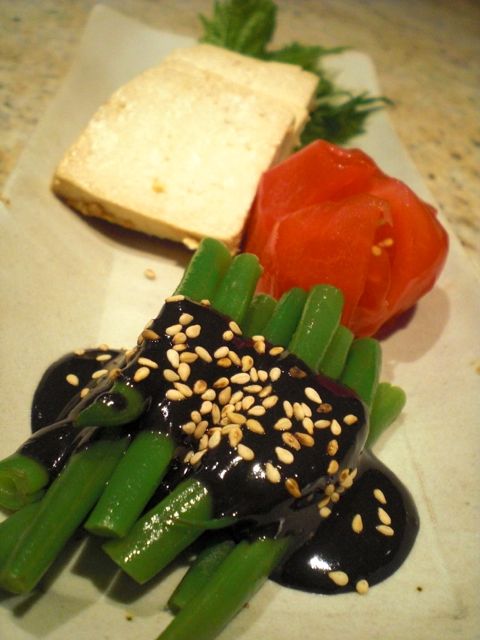
Not many food items are completely black; black sesame, nori sea weed, and squid ink are three I can think of. Some Japanese food products do contain charcoal powder and black, touting some health benefits, but I do not consider pure carbon powder food.
In any case, I trimmed and boiled green beans for 5 minutes or so until cooked but still crunchy. I immediately shocked them in ice water to make the color bright and to stop the cooking.
Dressing: I put the black sesame paste (3 tbs) in a small Japanese mortar or "suribachi" すり鉢 and added sugar (1 tsp), soy sauce (1 tsp) and mirin (2 tsp). Using a pestle "surikogi" 擂り粉木, I mixed it until a nice saucy consistency is reached.
I garnished it with roasted white sesame seeds. The taste is similar to white sesame paste but the visual effect is quite different. I served this with slices of miso-marinated tofu. This dish really depends on the quality of the green beans. Some green beans have tough skins and no matter how long you cook them, the skin remains tough and fibrous. This time, we were lucky. These beans were still crunchy but not fibrous at all and the black sesame dressing looked nice with great contrast to the red of tomato and white of tofu.
Saturday, November 19, 2011
Baked pork tenderloin salad オーブン焼き豚ヒレ肉のサラダ
Am I having too many padding posts? I usually have two cooked meats readily available in our refrigerator--oven roasted pork tenderloin and microwaved chicken breast. This time it was the left-over pork that I used. I made this pork tenderloin several days ago using a dry rub I recently came up with (a mixture of ground smoked paprika, cumin, clove, cinnamon, black pepper and salt). Without searing the surface of the pork I put it in a 350F oven for 30 minutes or until temperature of the thickest part registers 145F. The pork came out very tender and flavorful and it is surprisingly easy to make.

Using this tender and moist pork, I made this quick salad as a starter. I used all the usual suspects; small cubes of cooked pork tenderloin, snake-belly cut American mimicucumber, skined and quartered Campari tomato, finely chopped scallion and baby arugula. The cucumber was first dressed in sushi vinegar and then the excess liquid was squeezed out before comabining with the rest.
The dressing is simple store bought (real) mayonnaise, Dijon mustard, soy sauce and Japanese 7 favored red pepper powder 7味唐辛子. For good measure, I sprinkled 7 flavored pepper on the top.
The dressing is simple store bought (real) mayonnaise, Dijon mustard, soy sauce and Japanese 7 favored red pepper powder 7味唐辛子. For good measure, I sprinkled 7 flavored pepper on the top.
We had this with a highly extracted Napa Cab loaded with fruits and full body, Hall Cabernet Sauvignon 2008. RP gave 95. With this price point, this is a good buy.
Thursday, November 17, 2011
Otokomae tofu 男前豆腐
The kind of Japanese dishes I can make in the U.S. is really driven by what ingredients are available. I may have lamented the fact that the tofu we could get here was not really good especially the kind found in the supermarket. One of the Kyoto tofu makers called "Kyozen-an" 京禅庵 built a factory in New Jersey some years ago and their tofu was pretty good but after the incidence of salmonella contamination in their bean sprout products and failing FDA inspection, their tofu is no longer available in our near-by Japanese grocery store. Last weekend, when I was there, however, I found another Kyoto tofu called "Otokomae tofu" 男前豆腐. Sometime ago, I read about this tofu maker in Kyoto foodie.
So, without hesitation, I bought one. It came in a very un-traditional shaped container (shaped like a surf board) and the printing on the front said something like "Blowing in the wind tofu maker, Johnny". "Johnny" is supposedly the nick name of the president of the company, Shingo Ito. I also noticed that the bar code on the lower right is shaped like a wave (tune 90 degree anti-clock wise) with a surfer on it (You will find a close up image at Kyoto foodie). It also states that it contains Hokkaido daizu 大豆 soy bean and natural coagulant (nigari にがり) from Okinawan sea water.
So, without hesitation, I bought one. It came in a very un-traditional shaped container (shaped like a surf board) and the printing on the front said something like "Blowing in the wind tofu maker, Johnny". "Johnny" is supposedly the nick name of the president of the company, Shingo Ito. I also noticed that the bar code on the lower right is shaped like a wave (tune 90 degree anti-clock wise) with a surfer on it (You will find a close up image at Kyoto foodie). It also states that it contains Hokkaido daizu 大豆 soy bean and natural coagulant (nigari にがり) from Okinawan sea water.
In any case, I figured that this could not be bad. I also thought that this type of tofu was best eaten as is. I scooped up the tofu into glass bowls. Instead of my usual condiments for cold tofu, I decided to go with the simplest way to really enjoy the flavor of tofu.
As you can see below image, I served this tofu with green tea salt-obviously, the green one on the right and "Yukari" ゆかり salt - red one on the left - which is dried red perilla and salt, by-products of making picked plum or "umeboshi" 梅干し.
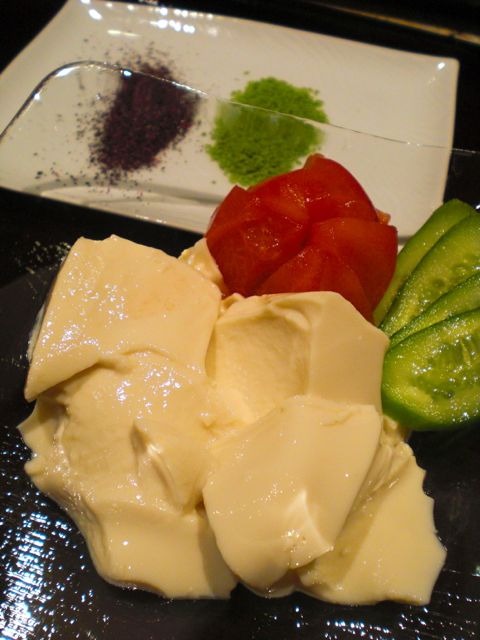
Most Westerners think tofu does not have any taste. Actually many supermarket varieties even have some unpleasent smell and taste. This tofu has a real nice flavor of soy beans and unctious creamy texture. We just sprinkled either green or red salt and really enjoyed this tofu. Hope I can get this next time I go to this Japanese grocery store (the only such store left in the neighbourhood).
Tuesday, November 15, 2011
Sautéed scallops two ways; with nori and egg yolk 帆立貝の黄金焼き、海苔焼き
Hokkaido is famous for scallops among other sea food and I am partial to it but, come to think of it, I have not cooked scallops that often. So, I decided to make this dish one weekend.

I thought I would make a standard scallop dish called a "Golden grilled" scallop. This dish uses only an egg yolk which leaves the egg white behind. So I also made "nori coated scallop" or "Seashore grill" 磯辺焼き using the egg white.
For the golden scallops, I placed the sautéed scallops on a metal tray in a toaster oven on grill mode. I brushed the egg yolk mixture over the grilling scallops several times until a golden crust formed (2-3 additional minutes).
I got medium sized "dry" sea scallops. In an ideal situation, you would like to get fresh ones with roes (liver) and membrane ("himo" 紐 in Japanese) attached but the ones I got were just the muscle. I removed the hard small bundle of muscle from the main muscle. I washed and patted dry. I salted the scallops but did not use any marinade this time.
I separated a pasteurized egg into the yolk and white. I mixed a small amount of mirin (less than 1 tsp) and salt into the egg yolk.
I tore the nori into small pieces. I dipped half of the scallops into the egg white and then rolled them in the nori to coat. The remaining scallops and the nori coated scallops were then sautéed in melted butter on medium high heat until both side were nicely brown turing once for 1 minutes or so depending on the thickness of the scallops. (Do not over cook). I took out the ones I was using for golden scallops before they were completely cooked. I left the nori coated ones for another 30 seconds to complete cooking.
For the golden scallops, I placed the sautéed scallops on a metal tray in a toaster oven on grill mode. I brushed the egg yolk mixture over the grilling scallops several times until a golden crust formed (2-3 additional minutes).
In the same sauté pan I used to cook the scallops, I added green asparagus (skin peeled and the bottom portion cut into several pieces on a slant) and snow peas. I cooked them for a few minutes in the remaining melted and browned butter seasoned with salt and pepper.
I placed scallop shells on the plate covered with a layer of Kosher salt to make the shells stable. I garnished the golden scallops with the green part of a scallion cut in a decorative shape and served with a side of asparagus. For the nori-coated scallops, I added a garnish of snow peas.
This is a perfect drinking snack. Both recipes have some variations. For golden scallops, you could add miso and sugar to the egg yolk. For Isobe scallops, you could marinade the scallops in a mixture of mirin and soy sauce before grilling or sautéing and instead of small pieces of nori, you could use a larger rectangle of nori to wrap the cooked scallops.
Sunday, November 13, 2011
Sake steamed chicken and avocado 酒蒸し鶏肉とアボカドのピリ辛和え
This is another padding post but is a quick and nice drinking snack in the true spirit of Izakaya food as long as you have a cooked chicken and ripe avocado. As I mentioned in another post, roast pork tenderloin and microwaved sake steamed chicken are regulars in our refrigerator.
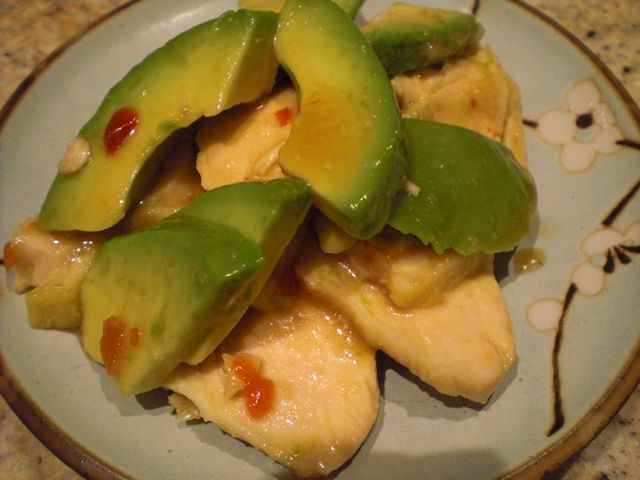
The idea for this dish came from tuna and avocado cubes. I just sliced the cooked chicken breast with skin attached and quartered the avocado slicing it into pieces on the slant.
I am really fond of microwave sake steamed chicken breast. It is so easy to make and is a nice thing to have in the refrigerator which can be used many different ways. The sauce really makes this dish come alive. The spiciness combined with the tender texture of the chicken juxtaposed to the texture and taste of the avocado makes this dish much more than the sum of its parts.
For sauce, I mixed grated garlic (1 small clove), garlic chile paste (1/4 tsp), sesame oil (1/2 tsp), ponzu shouyu (1 tsp) and semi congealed liquid from the container where the chicken breast was kept (1 tbs).
I am really fond of microwave sake steamed chicken breast. It is so easy to make and is a nice thing to have in the refrigerator which can be used many different ways. The sauce really makes this dish come alive. The spiciness combined with the tender texture of the chicken juxtaposed to the texture and taste of the avocado makes this dish much more than the sum of its parts.
This dish will go well with any drink but we were having cold sake with this.
Friday, November 11, 2011
Nagaimo pancake トロロ焼き
Since we do not have easy access to an Izakaya, I check Izakaya blogs to get vicarious enjoyment out of their reports. I saw this dish called "tororo-yaki" in one such Izakaya blog that the author found when drinking in an "Okonomiyaki" place. ("Tororo" is the name for grated yamaimo or nagaimo). Japanese pancake or "okonomiyaki" お好み焼き is not one of our favorites. For us, it tends to be too heavy and with so many ingredients all mixed together the taste is muddy--like the color you get when you mix all the colors in the paint box together. But, this one looked very interesting and I decided to try it. While the aforementioned blog, described the dish and included pictures of the final product including each step showing how to cook it, the blog did not include the recipe per se. So if I wanted to taste the dish I just had to come up with the recipe--as I imagined it must have been made.
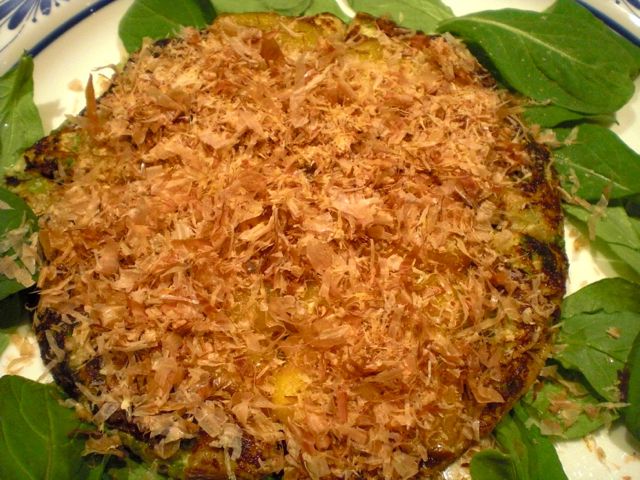

The first pictures above shows the final product. I topped it with cheese (picture directly above) and added dried bonito shavings or "katsuobushi" 鰹節 (top picture). I served it cut into 4 pieces using a pizza cutter and with a little of soy sauce.
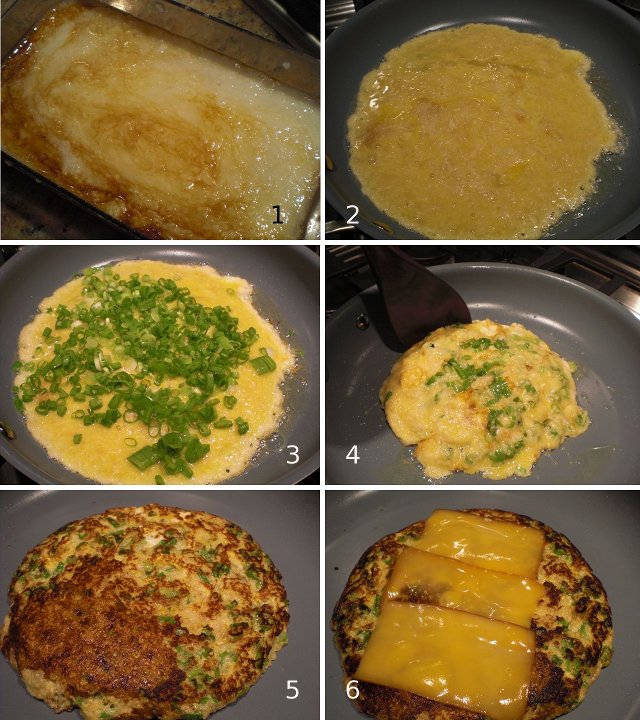
I placed the pancake on the bed of baby arugula and spread shaved bonito flakes with a bit of soy sauce.
I surmised the original recipe may have used "mountain yam" 山芋 but I only had the domesticated version called "Nagaimo" 長芋. Since nagaimo is not as sticky as yamaimo and a bit more watery, I decided to mix in an egg.
I grated the nagaimo (about 1 cup) and mixed in soy sauce (1 tsp) (#1). I then added one beaten egg and poured it in a non-stick frying pan with a small amount of vegetable oil (1 tbs) on a medium flame (#2). When the bottom was set, I spread finely chopped scallion on top (3 stalks) (#3). Using a spatula, I started folding the edges toward the center all around (#4). After several minutes, I flipped the pancake until both sides were brown (#5). I placed three slices of smoked aged cheddar cheese on top (my wife's choice) and put the lid on for another 1-2 minutes until the cheese melted (#6).
This is a very interesting dish--in a good way. The center was still soft and the scallion flavor was well integrated. It had the mouth feel of the most tender-delicate french omelet you've ever tasted and yet it was very clearly not an omelet. My wife's choice of smoked cheddar added depth of flavor and almost a sense of barbecue that went surprisingly well with the bonito. We really liked this dish and cold sake was the perfect choice.
Wednesday, November 9, 2011
Microwave sake steamed chicken with black vinegar gelée and myouga マイクロウェイブ酒蒸し鶏胸肉とミョウガの黒酢ジェレー
This is another nothing quick dish but a perfect Izakaya food. Recently, I have been making sake steamed chicken breast by microwaving chicken in a silicon steamer for microwave. I usually do not cook anything in the microwave (just re-heat), so this is new development for me. But if precisely timed and allowed to rest for 10 minutes or longer, the chicken comes out perfectly and cleaning up is much simpler.

Here is how I do it. I usually get bone-in and skin-on split chicken breasts. I remove the bones (do not leave the wish bone behind) and tenderloins (use for another dish). I remove any excess skin and fat but I keep the skin. Keeping the skin makes the chicken moist during the microwaving. If you like the skin, you could leave the skin or remove the skin after cooking. After removing excess fat from the cooked skin, I cut it in thin strips and use it in salad etc but this is totally up to you.

I let it steam in the container with the lid on after I remove it from the microwave. Some times, as it cools, the silicon container may buckle since the lid is rather tight. I place the container on a plate to prevent possible spillage (Spillage has not happened to me so far). When the chicken cools down enough so that you can handle it safely (10-15 minutes), you can use it in whatever dish you like.
In any case, I placed two half breasts in a silicon microwave steamer after somewhat liberally salting both sides. I then added slices of ginger root, and scallion (two stalks lightly bruised). I poured sake (3-4 tbs) (image below left) and put on the lid (image below right) and microwaved it for 5 minutes and 30 seconds (Mine is 600W, please adjust the time depending on the power of your microwave).
This time, I had fresh myouga 茗荷. So I halved and thinly sliced the myouga. I also made jabara cucumber. I sliced the chicken after removing the skin. I scraped off any excess fat from the back of the skin and cut it in thin strips. I put the strips of skin on the top of the chicken slices resting on a base of baby arugula. I sprinkled yuzu-souyu sauce (from the bottle) and garnished with small chuncks of black vinegar/soy sauce gelee (top image).
I think the chicken turned out better than the conventional way of sake steaming. Few important tips include finding out the exact timing, getting equal sized half breasts which will snuggly fit in the silicon steamer, and letting it steep in the container with the lid on until cool. Before I got the timing right, I undercooked and overcooked it few times. Now this is so easy and quick to make. Once I made the chicken this way, I keep it in a sealed container in the refrigerator and make small Izakaya dishes and sandwiches. The liquid left in the container is also very flavorful and lightly congeals in the fridge. You coudl just coat the slices of chicken with it or add it to you sauce, which adds wonderful mouth feel and flavor.
Monday, November 7, 2011
Soba Salad そばサラダ
This is not really a "dish" but nice small drinking snack or even a small "shime" 締め ending dish. This also was leftover control. There is no recipe but this is how I put it together,
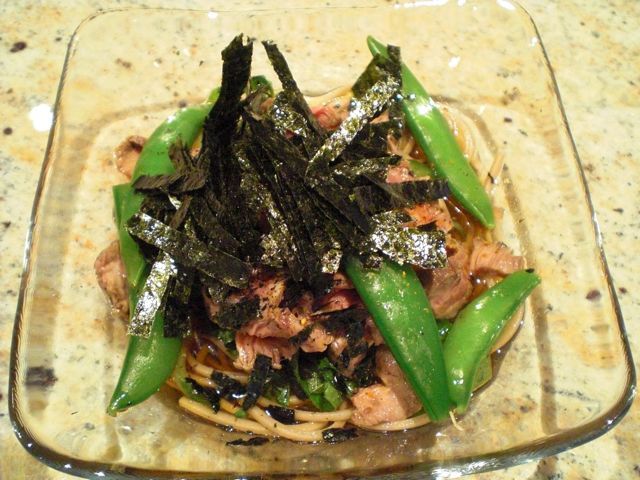
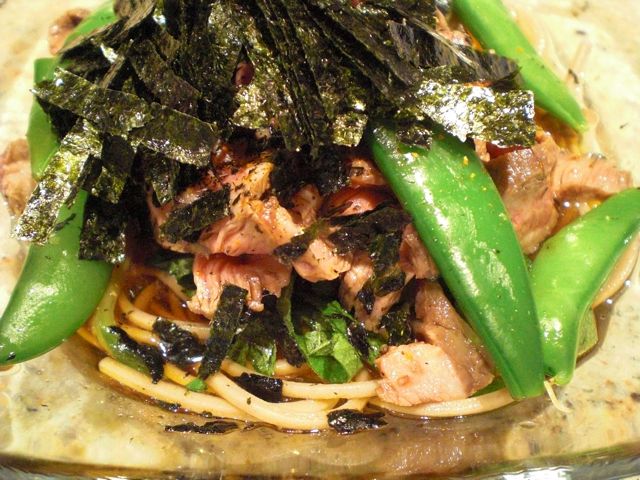
The amount is for two small servings. I had leftover flat iron steak which I used for several other dishes. I thinly sliced across that grain (4-5 slices per serving). I then marinated it with a small amount of concentrated (x2) bottled Japanese noodle sauce called "mentsuyu" 麺つゆ from the bottle without diluting. Of course, you could make your own.
This is a very decent dish. We really liked this type of soba noodle. It has nice firm texture but not too brittle. For my usual instant preparation, this is indeed in keeping with the spirit of Izakaya food.
I cooked half a serving of dried soba noodles. The one I had was called "yamaimo-iri" meaning containing mountain yam as a binder. This soba was nicely firm after cooking as per package instruction. I threw in sugar snaps (hand full, may be 10) toward the end of cooking the soba. I had to fish them out and put them in cold water before the soba finished cooking. If you time it correctly, you could drain the sugar snaps together with the soba. I washed the soba in cold running water.
I placed the soba noodle in the bottom of a small bowl, placed the steak slices, sprinkled Japanese 7 flavored red pepper flakes 七味唐辛子 on the top, and garnished with sugar snaps, chiffonade of perilla, and nori. Other garnish choices may include scallion and dried bonito flakes.
For sauce, I simply diluted "mentsuyu" and poured it over from around the sides (not too much).
Saturday, November 5, 2011
Baked marinated tofu redux ピリ辛豆腐のオーブン焼き 第2弾
When I posted baked marinated tofu, I promised I would try it with frozen and thawed tofu. Here is the dish.

Tofu: I used firm tofu and froze it 24 hours in a freezer without taking it out of the package. The next day, I moved the frozen tofu to the refrigerator. It took two days to completely thaw. After that, I drained any excess moisture as I did with a regular tofu.
The result? I do not like the very dry and spongy texture that results from this method. The texture is different from more authentic freeze dried tofu called "shimidoufu" 凍み豆腐 or "kouyadoufu" 高野豆腐. My wife liked this version more than I did. Certainly I do not think this is worth the effort.
Thursday, November 3, 2011
Japanese Insalata Caprese 日本風カプレーゼサラダ
The title is a bit of stretch. This is a combination of miso marinated fresh mozzarella cheese, thin slices of tomato, perilla leaves and grilled miso.

The mozzarella cheese was marinated for a week (we just forgot we had this) in the mixture of miso and mirin as described before. I scraped off the miso marinade and sliced it.
We smeared a bit of the grilled miso on the slice of cheese and layered it with a small piece of perilla and a slice of tomato like insalat caprese. We really liked this combination of flavors. My wife really liked the miso and even ate a portion of miso I did not eat. That night, however, she was very very thirsty.
I used a sharp knife to remove the tomato skin (but I could have blanched it first). To make it more attractive, I made it to a "rose". If you are interested in making a tomato rose or flower, here is the instruction with pictures (in Japanese).
Grilled miso: I simply smeared the miso marinade in a thin layer in a porcelain spoon and held it over the gas fire for few minutes until the surface became brown and the miso was fragrant.
We smeared a bit of the grilled miso on the slice of cheese and layered it with a small piece of perilla and a slice of tomato like insalat caprese. We really liked this combination of flavors. My wife really liked the miso and even ate a portion of miso I did not eat. That night, however, she was very very thirsty.
Tuesday, November 1, 2011
Japanese style coleslaw with hot-smoked pork tenderloin 日本風コールスローと豚ヒレ肉の薫製焼き
Since my wife does not particularly like raw shredded cabbage, I usually end up making variations of coleslaw when I'm in the mood to eat some cabbage. I am not sure where I got the idea of adding raisins to coleslaw but I must have eaten coleslaw made that way in Japan. In any case, this is another quick snack made from whatever was available to go with a drink. The previous weekend, we barbecued (hot smoked) pork tenderloin (seasoned with chopped rosemary, black pepper and salt) which I have been using for sandwiches etc. This is the last of this pork. It has a spicy taste from both the smoke and black pepper.

Coleslaw: As a side, I quickly made this Japanese (I am not sure it is a Japanese or whatever) style coleslaw. I julienned cabbage after removing the thick veins. I then salted, mixed, and let it stand for 10 minutes and squeezed out the excess moisture. Meanwhile I plumped some raisins in a mixture of white vermouth and hot water (about a one to one ratio) for 5-10 minutes. I added mayonnaise and Dijon mustard to the cabbage. I tasted and added freshly cracked black pepper but no more salt (it was salty enough). I removed the excess liquid from the raisins and mixed them into the cabbage.
Pork: After I thinly sliced it, I dressed it with semi-thick "tonkatsu" sauce and Japanese hot mustard mixture.
This was followed by marinated tuna "sashimi". Instead of the usual side of daikon garnish, I made an instant "diakon" namasu, dressed in a mixture of mirin and sushi vinegar, and served it with the fine chopped meat of umeboshi or "bainiku" 梅肉 on the top.
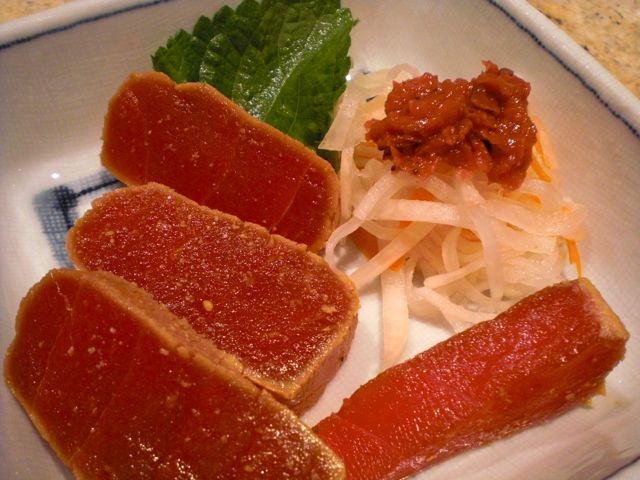
Again, we had cold sake. This time we tasted "junmai" sake from Kyoto, Kizakura 黄桜 Touzai Living Jewel. This is from a large sake brewery but made from Yamada nishiki. It is a light but nicely fruity and rather easy-to-drink sake, perfect for hot summer days, best chilled ice cold.
Pork: After I thinly sliced it, I dressed it with semi-thick "tonkatsu" sauce and Japanese hot mustard mixture.
As usual, I also added a drunken tomato. This is again nothing dish but rather spicy taste of pork went well with this coleslaw. The raisins added a nice sweet taste.
This was followed by marinated tuna "sashimi". Instead of the usual side of daikon garnish, I made an instant "diakon" namasu, dressed in a mixture of mirin and sushi vinegar, and served it with the fine chopped meat of umeboshi or "bainiku" 梅肉 on the top.
Subscribe to:
Comments (Atom)





